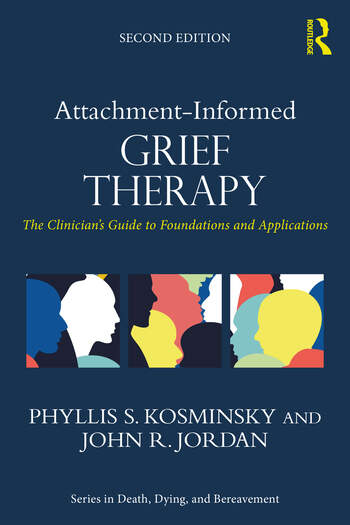Attachment-Informed Grief Therapy: The Clinician's Guide to Foundations and Applications

Book Details
- Publisher : Routledge
- Published : 2023
- Cover : Paperback
- Pages : 360
- Category :
Attachment Theory - Category 2 :
Grief and Bereavement - Catalogue No : 97611
- ISBN 13 : 9781032038445
- ISBN 10 : 1032038446
Reviews and Endorsements
Attachment-Informed Grief Therapy is a fascinating book! Kosminsky and Jordan have written a scientifically sound, clinically innovative, well-argued, and extremely informative volume. The authors show how insights from attachment theory and neuroscience are the keys that unlock the puzzle of healthy and disordered grief responses, and how, through understanding unmet attachment needs, attachment-related emotions and defenses, and the broaden-and-build repercussions of attachment security, grief therapists can help bereaved clients to manage their grief reactions and to find ways to move forward. I enjoyed reading this gracefully written and profound book and I strongly believe that it will become essential reading for clinicians, researchers, and students interested in the study and treatment of disordered grief.
Mario Mikulincer, professor of psychology, Baruch Ivcher School of Psychology, Reichman University, Israel
In this remarkable revision of their ground-breaking volume, Phyllis Kosminsky and Jack Jordan penetrate still more profoundly into the developmental, interpersonal, and intersubjective neurobiological underpinnings of attachment that give rise and form to all grief. More than a compendium of clinical wisdom and contemporary theory and research, Attachment-Informed Grief Therapy provides resonant insights and concrete principles for helping clients read the deep text of their own needs in the wake of loss. Equally, it instructs the reader in how to become the secure base that allows survivors to integrate the rupture and realign the bond with a significant other who is present even in absence. I, for one, am a better therapist and companion to those who mourn for the gift of their vision.
Robert A. Neimeyer, PhD, co-editor of The Handbook of Grief Therapy and director of The Portland Institute for Loss and Transition
The second edition of this important volume is a valuable resource for clinicians and researchers alike. Updating, expanding, and deepening their understanding of the interface between attachment styles and the processing of bereavement, Kosminsky and Jordan's integration of new findings from neuroscience adds an important dimension to their overview. The ample clinical material included is accompanied by rich and thoughtful consideration of the cases at hand. Accompanying these exemplary clinicians as they weave together theory, research and practice on bereavement will enrich the therapeutic encounter for therapists at all stages of their professional development.
Simon Shimshon Rubin, PhD, director of the International Laboratory for the Study of Loss, Bereavement, and Human Resilience at the University of Haifa, Israel, and co-author of Working with the Bereaved: Multiple Lenses on Loss and Mourning
Reading this book in one stitting, as I did, left me moved. It starts with a crystal-clear exposition of contemporary attachment theory and its neuroscience basis, defines and easy-to-understand attachment framework for helping bereaved people, and shows how sensitive therapy can help overcome physiological dysregulation and restore meaning. Convincing clinical illustrations are used throughout, contributing to an overall sense of two vastly experienced clinicians passing on deep theoretical and practical expertise to the next generations. Strongly recommended.
Jeremy Holmes, MD, FRCPsych, University of Exeter, United Kingdom, and author of Exploring in Security: Towards an Attachment-Informed Psychoanalytic Psychotherapy
Grief, that harrowing experience after the death of a loved one, is again beautifully described in the second edition of Attachment-Informed Grief Therapy. What the authors have accomplished in this edition will continue to enrich how clinicians work with the grief-stricken and will provide them with an expanded knowledge of how attachment shapes the experience of grief in bereavement. And Kosminsky and Jordan do more. The rhythm of the writing combined with their clarity and deftness in explicating theory and neuroscience make Attachment-Informed Grief Therapy a book that is a pleasure to read.
Dorothy Holinger, PhD, author of The Anatomy of Grief

